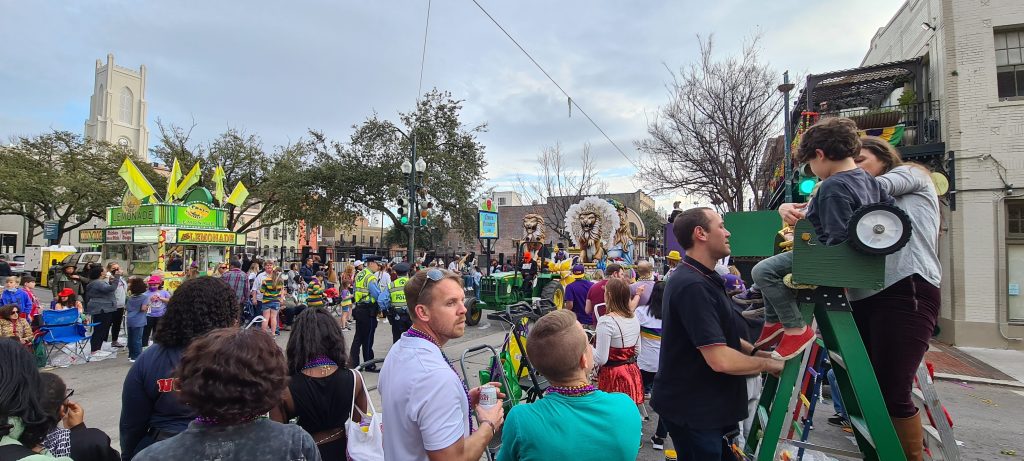On 20th February 2022, we went to the intersection of Girod Street and St. Charles Avenue to watch the Krewe of King Arthur roll by. A little daunted by the aggression of some of the throwing of throws we witnessed on Canal Street earlier in the day, we approached with some trepidation (though Patrick was intent on getting a branded throw for is son, Arthur). As we approached, it became clear that the atmosphere here was much different to that on Canal Street: families were gathered, conversation was flowing and people were helping each other to catch and collect throws.

A few minutes after arriving, we noticed three girls across the street trying to attract the attention of those opposite. Making eye contact, they bounced small bouncy balls across the street when the parade came to a halt every now and again. This became an ongoing means of communication across the space; a silent performance of community, joy and collaboration evolved over the next couple of hours. Hand signals, reaching to catch, eye contact, pointing, occasional vocal calling and much laughing came together to create a conversation between strangers; the girls and (what we took to be) their parents on one side, a slowly rotating/changing group of parade goers of all ages on the other. There was no hierarchy, no competition. The game was inclusive, spontaneous and joyful; participants laughed, feigned exasperation if a catch was missed, and actively looked to reengage one another if the conversation was interrupted by the passing of floats or marching bands.
An elderly couple dance on a balcony opposite our position. They laugh with one another and with those in the crowd who spot them and dance ‘with’ them from the pavement. They, and we, sing to familiar lyrics played by passing trucks or brass bands. These performances create and enact communitas; people are brought together through joyful practices that encode a sense of (perhaps temporary) belonging, equality and understanding. This is an experience of being together in time and space, of being part of something bigger than one’s self. Though perhaps an idealised reading of carnival – and one that needs more critical attention to some more problematic gendered representations of sex, sexuality and race, the performances on Girod and St Charles suggest means of understanding the political potential of carnival beyond its excessive consumption and histories of segregation.
This impromptu community of participants cut a striking difference to the seeming aggression of earlier encounters between parade goers and float riders. The ball game seemed, by design or accident, to enable revellers to participate in the embodied experience of carnival with a greater degree of connection to one another, rather than clamouring for only for the ‘magnificence’ of receiving a particular set of beads, a doubloon or two, or a sought-after handmade gift. This social performance lent weight and clarity to the experience: carnival became visible as an opportunity to connection across race, class and age lines.
